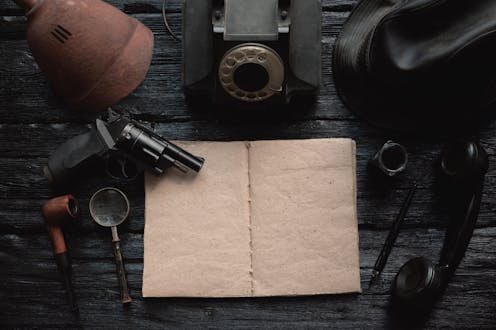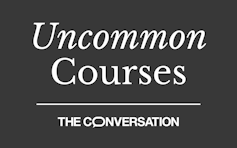

Uncommon Courses is an occasional series from The Conversation U.S. highlighting unconventional approaches to teaching.
Title of course:
Whodunit?: Detective Stories
What prompted the idea for the course?
I had just finished reading one of Dorothy Sayers’ novels – “Gaudy Night,” which in my opinion is one of the best of her detective novels featuring Harriet Vane and Lord Peter Wimsey. A colleague and I were discussing Harriet’s ability to delve into the secrets of a women’s college at Oxford, when it occurred to me that I would have loved a detective fiction class as an undergraduate.
Although professors throughout my studies enjoyed talking about detective stories, I had never heard of any class devoted exclusively to studying them. So when the English department where I teach asked for proposals for new courses, I submitted one. It also seemed like a good way to connect with students. They could become literary detectives – reading closely, finding clues, forming theories. It also gave me the chance to research and teach stories I’ve enjoyed for years.
What does the course explore?
By focusing on the development of different types of detectives – the police, the private, and the female – we look at the historical development of the characters and the forms of justice over time: divine, social, moral, legal and even poetic.
We read stories in which the “mysterious hand of God” or another mysterious source deals justice, such as in stories by Melville Davisson Post, G.K. Chesterton, and J.B. Priestly. Or in which private detectives choose the means of justice, as is the case in stories by Sir Arthur Conan Doyle and Sue Grafton. Or in which justice is never served, as in works by Clark Howard and Ian Rankin.
Why is this course relevant now?
Not only does the course offer, for many, an unexpected approach to academic reading, but it also offers a way to make sense of some of the craziness of the world. Students have fun searching the text for clues and thinking critically about language and how sociopolitical contexts shape our current thoughts about crime and justice.
Also, at the end of many detective stories, we not only see how the events fit together to solve the crime, we also get to see which events fit and which are red herrings. The detective narrative makes sense of seemingly unrelated events in, perhaps, a more obvious way than other fiction.
What’s a critical lesson from the course?
I think there are two critical lessons from the course: the importance of reading critically and the importance of historical and social context. Most authors we read use fair play, the clues are there for the readers, so reading critically is important for figuring out whodunit on a basic plot level.
This kind of close reading leads to questions about how authors convey ideas and how to read critically to discover them. Part of this critical reading involves understanding the historical and social context in which they are written, such as how an American story written during WWII with Germans as villains can be used as propaganda.
What materials does the course feature?
Because the course covers the development of different types of detectives, we start with what’s widely considered one of the first police detective novels in English, “The Moonstone” by Wilkie Collins, which was first published serially in one of Dickens’ magazines in 1868. From there we work our way to late 20th- and early 21st-century police stories.
For the private detective, we read stories by Edgar Allan Poe, Sir Arthur Conan Doyle, and Agatha Christie, as well as American hard-boiled private investigator – or PI, or private eye – fiction by writers such as Dashiell Hammett and Raymond Chandler.
We also cover the female detective from the Victorian period up to later 20th-century detectives in P.D. James’ “An Unsuitable Job for a Woman” and Sue Grafton’s Kinsey Millhone stories.
What will the course prepare students to do?
At the end of the course, students will, I hope, take joy in reading closely and thinking critically about what they read. My goals are that they’ll understand how the genre developed in relation to history and have a sense of the complexities of historical notions of crime and justice – oh, and that they’ll be wary of narrators, look for red herrings, consider motives and avoid forming theories without facts.
Sally C. Harris does not work for, consult, own shares in or receive funding from any company or organization that would benefit from this article, and has disclosed no relevant affiliations beyond their academic appointment.
This article was originally published on The Conversation. Read the original article.







